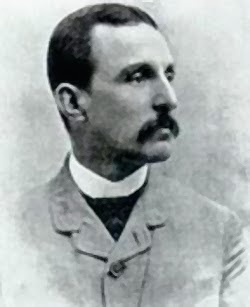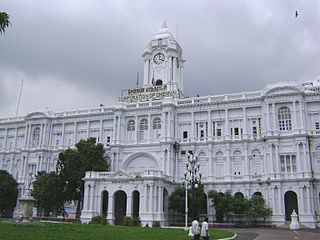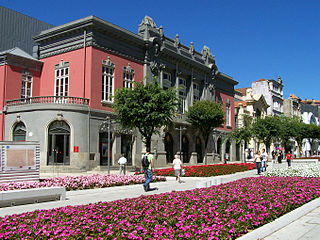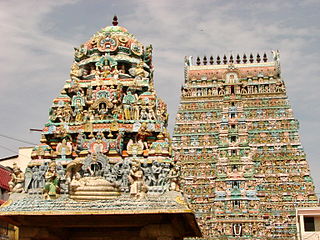
Braga is a city and a municipality, capital of the northwestern Portuguese district of Braga and of the historical and cultural Minho Province. Braga Municipality had a resident population of 201,583 inhabitants, representing the seventh largest municipality in Portugal by population. Its area is 183.40 km2. Its agglomerated urban area extends to the Cávado River and is the third most populated urban area in Portugal, behind Lisbon and Porto Metropolitan Areas.

The Municipal Stadium of Braga is an all-seater football stadium located in Braga, Portugal, and the current home of Sporting Clube de Braga. It has a capacity of 30,286 spectators, making it the seventh largest football stadium in Portugal. The stadium was designed by Portuguese architect Eduardo Souto de Moura who was awarded the Pritzker Architecture Prize in part for this design.
The year 1840 in architecture involved some significant architectural events and new buildings.

The General Post Office, Mumbai, is the central post office of the city of Mumbai, India. The post office handles most of the city's inbound and outbound mail and parcels. Situated in the vicinity of Chhatrapati Shivaji Terminus, the Mumbai General Post Office (GPO) is a paradigm of Indo-Saracenic architecture.

Indo-Saracenic architecture was a revivalist architectural style mostly used by British architects in India in the later 19th century, especially in public and government buildings in the British Raj, and the palaces of rulers of the princely states. It drew stylistic and decorative elements from native Indo-Islamic architecture, especially Mughal architecture, which the British regarded as the classic Indian style. The basic layout and structure of the buildings tended to be close to that used in contemporary buildings in other revivalist styles, such as Gothic revival and Neo-Classical, with specific Indian features and decoration added.

Henry Irwin was an architect of British India. He is mainly known for his works in Indo-Saracenic style of architecture. He was a member of the Institution of Engineers. He was awarded a CIE in the 1888 Birthday Honours.
George Wittet (1878-1926) was a Scottish architect who worked mostly in Mumbai, India.

Chennai architecture is a confluence of many architectural styles. From ancient Tamil temples built by the Pallavas, to the Indo-Saracenic style of the colonial era, to 20th-century steel and chrome of skyscrapers. Chennai has a colonial core in the port area, surrounded by progressively newer areas as one travels away from the port, punctuated with old temples, churches and mosques.

Frederick William Stevens was an English architectural engineer who worked for the British colonial government in India. Stevens' most notable design was the railway station Victoria Terminus in Bombay.

The Ripon Building is the seat and headquarters of the Greater Chennai Corporation in Chennai, Tamil Nadu. It is an example of neoclassical architecture, a combination of Ionic and Corinthian styles. The Ripon Building is an all-white structure and is located near the Chennai Central railway station.

The Theatre Circo is a 20th-century, Portuguese revivalist theatre, in the civil parish of São João do Souto, municipality of Braga. Designed by the architect João de Moura Coutinho, it was first inaugurated on 21 April 1915 with a performance of Ruggero Leoncavallo's operetta La reginetta delle rose.

Sir Samuel Swinton Jacob,, known as Sir Swinton Jacob, was a British Army officer and colonial engineer, architect and writer, best known for the numerous Indian public buildings he designed in the Indo-Saracenic style.
The architecture of Mumbai blends Gothic, Victorian, Art Deco, Indo-Saracenic & Contemporary architectural styles. Many buildings, structures and historical monuments remain from the colonial era. Mumbai, after Miami, has the second largest number of Art Deco buildings in the world.
Robert Fellowes Chisholm was a British architect who pioneered the Indo-Saracenic style of architecture in Madras.

The Senate House is the administrative centre of the University of Madras in Chennai, India. It is situated in Wallajah Road, along Marina Beach. Constructed by Robert Chisholm between 1874 and 1879, the Senate building is considered to be one of the best and oldest examples of Indo-Saracenic architecture in India.
Hilton Chennai is a five-star luxury hotel located on Jawaharlal Nehru Road at Guindy, Chennai, India. It is located next to the Olympia Technology Park and close to the Kathipara Junction. Built in the Indo-Saracenic style with an initial investment of ₹ 4,000 million, it is Hilton's fourth Indian property after Hilton (Janakpuri), Hilton Garden Inn (Saket), both in New Delhi, and Hilton Mumbai International Airport. and was inaugurated by Indian Overseas Bank Chairman and Managing Director M. Narendra on 28 February 2011.
Bharat Insurance building is a heritage building in Chennai, India. Located on the arterial Anna Salai, it was built in 1897. Originally known as Kardyl Building, the building is an example of the Indo-Saracenic architecture, a hybrid of Muslim design with Indian materials.

Southern Railway headquarters administrative building, Chennai, is an Indo-Saracenic structure located adjacent to the Chennai Central on Poonamallee High Road.

The National Art Gallery situated in Egmore, Chennai, is one of the oldest art galleries in India. It is located in the Government Museum Complex on Pantheon Road, Egmore, which also houses the Government Museum and the Connemara Public Library. Constructed with red stones sourced from Satyavedu in Andhra Pradesh, the Gallery was built in 1906 in Indo-Saracenic architecture and houses paintings from Thanjavur, Rajasthan, Kangra and Deccan areas, as well as sandalwood sculptures. The Gallery has remained closed since 2002, as part of the structure suffered damage.

Tamil Nadu is known for its ancient temple architecture. Nearly 33,000 ancient temples, many at least 800 to 2000 years old, are found scattered all over Tamil Nadu. As per Tamil Nadu Hindu Endowments Board, there are 38,615 temples. Most of the largest Hindu Temples are located in Tamil Nadu. Studded with complex architecture, a variety of sculptures, and rich inscriptions, the temples remain the very essence of the culture and heritage of Tamil land, with historical records dating back to at least 3,000 years.















